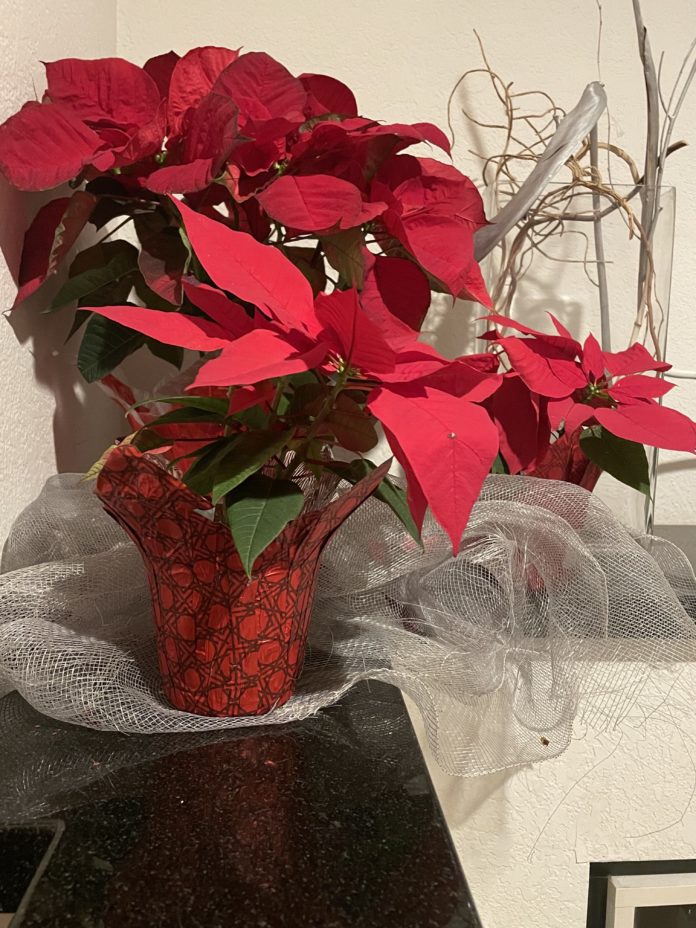What Shall I Do with my Poinsettias?
When I was a teenager, my parents bought a home in Brentwood, a Los Angeles neighborhood. I loved my bedroom. It was just big enough to put a twin bed on two opposite walls with a bookcase and planter between them. A high window was above the garage which shared the beds’ wall. On the exterior wall against which one of the beds sat was a window which ran along most of the wall and began about four feet above the floor to just below the ceiling. In winter I could see the bracts and blooms of myriad poinsettia plants outside that window. Although they were green most of the year, they bloomed faithfully every winter. I don’t think I’ve ever had a room that pleased me as much as that one. Perhaps that is why I still have a warm spot for poinsettias.
Many of us use poinsettias to add a festive air to our homes during the holidays. I buy several poinsettia plants because I gave all my tree ornaments away years ago. No one was enthusiastic dismantling the tree; even decorating it became a lonely event: the kids went off with friends, and my husband had already arranged the lights. After Christmas, my mother-in-law always worked with me, carefully wrapping each ornament to preserve it another year. She died one December, before the tree came down; I was left with her job. I told my children to take the ornaments; they could do with them what they pleased, and I have had no tree since. Poinsettias need not be wrapped and stored like ornaments.
If you want to use your blooming poinsettia next year, or if you prefer potted plants to landscape plants, your decorative poinsettias need some care and attention. While they bloom, they need to be protected from drafts in room with a moderate temperature: 65 to 70 degrees in daytime; above 60 degrees at night. They will be happy with at least six hours of bright, indirect sunlight a day. Cooler night temperatures help prevent leaf drop. Water the plants regularly until spring, removing dead or faded leaves as they appear. In early spring, gradually let the soil dry. By mid-April, they may become leggy. You might trim them to about four inches above the soil. Now, move the pots to an outdoor shady area. Let them stay in shade about a month until they are ready for full sunlight. Then prepare the soil in your garden so it gets good drainage. Take out each poinsettia, making certain the roots are happy and free, and put it in the sunny garden. Water thoroughly. You may want to prune it in July pinching about an inch from the end of each stem. In September, you might trim it again, cutting off two to three inches to encourage side branches to grow. Sometime during winter, bracts and blossoms will appear.
Indoor poinsettias need more attention if you want blooms. Until April, they need the same care as the outdoor plants received. By mid-April or May, your plants are probably rootbound and will need larger pots. Fill each new pot with fresh, sterile potting soil adding some pebbles or coarse sand to allow good drainage. You will need to loosen the roots to encourage them to spread out in their new soil. Water them thoroughly. Trim each of the stems to about four inches above the dirt. Put your plants back in the window and only water them when the top of the soil is dry.
Once new growth appears, fertilize your plants every few weeks with regular houseplant fertilizer. When night temperatures are over 50 degrees, move your plants outdoors, in their pots, to a partially shady spot. Gradually move them into full sun. Pruning indoor poinsettias is not unlike what one does for landscape poinsettias. In early to mid-July, you may trim about an inch from each terminal growth on each stem. Give your poinsettias another trim in early September removing two or three inches of stem, leaving three or four leaves on each branch. Like the landscape plants, this encourages side branching.
When the temperature drops to 55 to 60 degrees, bring your plants back indoors by the sunny window. Maintain the same temperatures you did when your plants were new and continue to feed and water as you have been doing.
In October, you will begin conditioning your poinsettias to bloom. Keep them in a completely dark closet or in a box for at least 12 to 14 hours daily from early October until Thanksgiving. They need to be in total darkness from sundown until perhaps 8 or 9 in the morning. Return them to the window for the rest of the day. After Thanksgiving, they will no longer need darkness; however, they will need at least six hours in a sunny area each day. Reduce water and fertilizer, and cross your fingers. With luck, by mid-December your poinsettia should be abloom.
I have never put my ten-year-old potted poinsettia that has lived most of its life outdoors into total darkness, and it still blooms. It bloomed in 2020, never was pruned as it continued to bloom all of 2021 and still has a few colorful bracts and blossoms. I plan to augment our landscape with my current decorative poinsettias when I prune the old one. If I am lucky, they’ll live!
From 6:30 p.m. to 8 p.m., Thursday, February 24 there will be a lecture at the church at 4070 Jackdaw on Kokodema, a ball of moss-covered soil on which an ornamental plant grows.

Category: Education, Gardening, Local News, Plants







